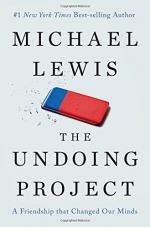|
This section contains 800 words (approx. 2 pages at 400 words per page) |

|
The Undoing Project Summary & Study Guide Description
The Undoing Project Summary & Study Guide includes comprehensive information and analysis to help you understand the book. This study guide contains the following sections:
This detailed literature summary also contains Topics for Discussion on The Undoing Project by Michael Lewis.
The following version of this book was used to create this study guide: Lewis, Michael. The Undoing Project. Penguin, 2016. Kindle AZW file.
The Undoing Project by Michael Lewis explores the lives and work of two Israeli psychologists - Amos Tversky and Daniel Kahneman – discussing their most significant contributions to the fields of psychology and economics and exploring some of the ways their ideas can be applied in everyday contexts.
Lewis begins by summarizing the cultural impact of one of his earlier books, Moneyball, about the use of data analytics in professional baseball. Lewis discusses Daryl Morey, a man who revolutionized the use of data in the recruitment of basketball players in his role at the NBA team the Houston Rockets.
The story of Danny and Amos begins by recounting their childhoods and early adulthood. Danny grew up in Paris, France but was forced to flee with his family after the Nazis invaded because they were Jewish. After the war, Danny’s family relocated to Palestine. Danny trained in psychology at Hebrew University before serving in the army as a psychologist, during which time he revolutionized the army’s approach to recruitment by trying to limit the ways human bias influenced decision making. Amos was born in Palestine and also grew up to train as a psychologist. During his army service, Amos won a medal for bravery after saving the life of one of his soldiers after an accident in a training exercise.
Danny and Amos first began working together after Danny invited Amos to speak at a class he was teaching at Hebrew University and responded by telling Amos that the ideas he spoke about were stupid. They became close friends and began collaborating on research together resulting in their first paper “Belief in the Law of Small Numbers” which demonstrated the existence of a systematic bias in human thinking that causes people to overestimate the significance of small sample sizes, even when the people being studied are trained statisticians. The paper was influential in their field and boosted their reputation.
They moved to the Oregon Research Institute in America to continue their collaborative research projects and wrote a paper called “On the Psychology of Prediction” which showed various errors that people consistently make when trying to predict future outcomes and make decisions. They worked with a medical student named Don Redelmeier to come up with scenarios where their ideas could be applied in a medical setting. Redelmeier continues to apply the theories of Danny and Amos in his practice as a doctor at hospital in Toronto where he helps doctors questions their own thought processes in order to avoid making errors.
Danny and Amos’s research was interrupted by the need to return to Israel to fight in the Yom Kippur War. They were both assigned to the psychology field unit and travelled through warzones together with psychological questionnaires. After the war, Amos and Danny began applying their theories to the field of economics. They published research showing that the decisions people make are affected by the context in which questions are put to them: this theory became very influential in the field of economics.
Danny left his wife and children in Israel in order to marry another psychologist, Anne Treisman, and he moved to America in order to live with her. Amos moved his family to America as well so that they could continue to work together. Amos was offered more prestigious jobs than Danny and they ended up working at separate institutions, travelling to visit each other and work together at weekends. Danny became increasingly resentful of the fact that Amos was often given sole credit for the work they produced collaboratively. This resentment, and Amos’s apparent unwillingness to set the record straight, slowly eroded their friendship and their working relationship. They began working together less and less.
Now that they were established as influential psychologists, Amos and Danny found that younger researchers were attempting to challenge and criticize their work. Amos became particularly obsessed with one such challenger Gerd Gigerenzer. He insisted that he and Danny had to write a fierce rebuttal of Gigerenzer’s criticisms: a task that Danny found distressing and depressing, eventually telling Amos that he could not bear to keep working on it. Shortly afterwards, Amos revealed to Danny that he had been told he was dying and only had a few months to live. After Amos’s death, Danny gave the eulogy at his funeral.
A few years after Amos died, Danny was under consideration for the Nobel Prize in Economics because of the influence of the work he did in collaboration with Amos. He won the prize and took Amos’s wife and children with him to the ceremony, appending his address with his eulogy for Amos.
Read more from the Study Guide
|
This section contains 800 words (approx. 2 pages at 400 words per page) |

|



